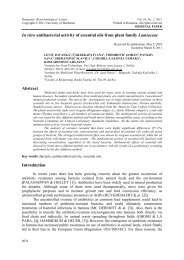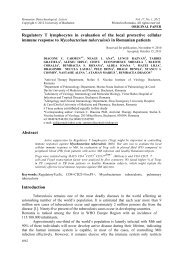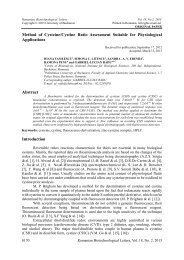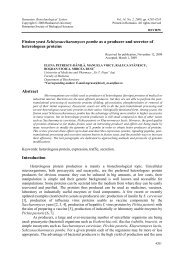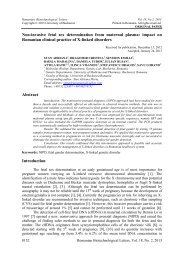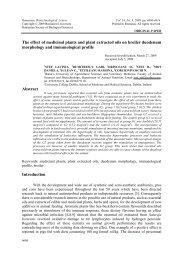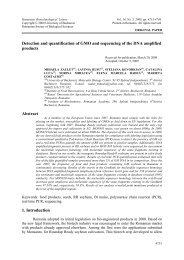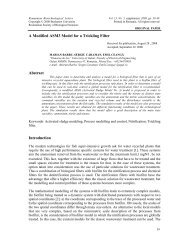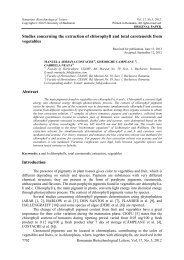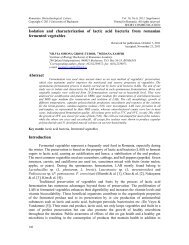Utilization of cassava wastes in the production of ... - Rombio.eu
Utilization of cassava wastes in the production of ... - Rombio.eu
Utilization of cassava wastes in the production of ... - Rombio.eu
Create successful ePaper yourself
Turn your PDF publications into a flip-book with our unique Google optimized e-Paper software.
Romanian Biotechnological Letters Vol. 17, No.3, 2012<br />
Copyright © 2012 University <strong>of</strong> Bucharest<br />
Pr<strong>in</strong>ted <strong>in</strong> Romania. All rights reserved<br />
ORIGINAL PAPER<br />
<strong>Utilization</strong> <strong>of</strong> <strong>cassava</strong> <strong>wastes</strong> <strong>in</strong> <strong>the</strong> <strong>production</strong> <strong>of</strong> fructosyltransferase by<br />
Rhizopus stolonifer LAU 07<br />
Abstract<br />
Received for publication, June 10, 2010<br />
Accepted, September 11, 2011<br />
A. LATEEF* ,1 , AND E. B. GUEGUIM KANA 2 ,<br />
1 Biotechnology Group, Microbiology Unit,<br />
Department <strong>of</strong> Pure and Applied Biology, Ladoke Ak<strong>in</strong>tola University <strong>of</strong> Technology, PMB<br />
4000, Ogbomoso. Nigeria.<br />
2 School <strong>of</strong> Biochemistry, Genetics and Microbiology, University <strong>of</strong> KwaZulu-Natal,<br />
Pietermaritzburg, Scottsville, South Africa.<br />
*Correspond<strong>in</strong>g author: agbaje72@yahoo.com; Tel.: +234 803 7400 520<br />
A newly isolated stra<strong>in</strong> <strong>of</strong> Rhizopus stolonifer LAU 07 was evaluated for <strong>the</strong> <strong>production</strong> <strong>of</strong><br />
fructosyltransferase (FTase), <strong>the</strong> enzyme responsible for <strong>the</strong> conversion <strong>of</strong> sucrose to<br />
fructooligosaccharide (FOS), a heathful food <strong>in</strong>gredient us<strong>in</strong>g locally available <strong>cassava</strong> <strong>wastes</strong> <strong>in</strong> both<br />
solid state (SSF, <strong>cassava</strong> peel) and submerged fermentations (SmF, <strong>cassava</strong> steep liquor). High titers<br />
<strong>of</strong> enzyme <strong>of</strong> more than 20 U/g were obta<strong>in</strong>ed when 5-15 % <strong>in</strong>oculum sizes were used with m<strong>in</strong>imal<br />
supplementation <strong>of</strong> <strong>cassava</strong> peels with yeast extract. Maximum FTase yield <strong>of</strong> 32.87 U/ml was obta<strong>in</strong>ed<br />
after 96 h <strong>of</strong> fermentation <strong>in</strong> <strong>cassava</strong> steep liquor, that was not supplemented with any nutrient. The<br />
systems are advantageous and economical for <strong>the</strong> <strong>production</strong> <strong>of</strong> FOS, <strong>in</strong> that <strong>the</strong> complex substrates do<br />
not require extensive supplementation to produce <strong>the</strong> enzyme with acceptable titer. The FTase yielded<br />
34 % <strong>of</strong> FOS (1-kestose, GF 2 ; nystose, GF 3 ) us<strong>in</strong>g 60 % (w/v) sucrose as <strong>the</strong> substrate. As far as we<br />
know, this is <strong>the</strong> first contribution towards <strong>the</strong> <strong>production</strong> <strong>of</strong> FTase and FOS by a species <strong>of</strong> Rhizopus<br />
us<strong>in</strong>g low-cost complex media obta<strong>in</strong>ed from <strong>cassava</strong> peel and <strong>cassava</strong> steep liquor. The large-scale<br />
availability <strong>of</strong> <strong>the</strong>se materials can make <strong>the</strong> process <strong>in</strong>dustrially relevant especially <strong>in</strong> Nigeria, where<br />
<strong>the</strong>se agricultural <strong>wastes</strong>/residues are generated <strong>in</strong> abundance.<br />
Keywords Rhizopus . Submerged fermentation . Solid state fermentation . Cassava <strong>wastes</strong> .<br />
Fructosyltransferase . Fructooligosaccharides<br />
Introduction<br />
Fructooligosaccharides (FOS) are important food <strong>in</strong>gredients that are rapidly<br />
becom<strong>in</strong>g popular because <strong>of</strong> <strong>the</strong> numerous health benefits, which <strong>in</strong>clude lower<strong>in</strong>g <strong>of</strong> <strong>the</strong><br />
blood cholesterol and glucose levels, enhancement <strong>of</strong> m<strong>in</strong>eral absorption <strong>in</strong> <strong>the</strong> body,<br />
ma<strong>in</strong>tenance <strong>of</strong> healthy <strong>in</strong>test<strong>in</strong>al microbiota, promot<strong>in</strong>g <strong>the</strong> growth <strong>of</strong> beneficial lactobacilli<br />
and bifidobacteria <strong>in</strong> <strong>the</strong> colon, prevention <strong>of</strong> <strong>the</strong> growth <strong>of</strong> pathogenic bacteria <strong>in</strong> <strong>the</strong> colon<br />
and prevention <strong>of</strong> colonic cancer [1]. The physicochemical attributes <strong>of</strong> FOS particularly <strong>the</strong><br />
relative sweetness to sucrose, bulk density and viscosity have also <strong>in</strong>creased <strong>the</strong>ir use <strong>in</strong> a<br />
number <strong>of</strong> food and pharmac<strong>eu</strong>tical applications. FOS are primarily produced <strong>in</strong>dustrially<br />
us<strong>in</strong>g fructosyltransferase (FTase) (E.C.2.4.1.9), which catalyzes <strong>the</strong> formation <strong>of</strong><br />
fructooligosaccharides from sucrose. Several fungi have been reported to possess<br />
transfructosylat<strong>in</strong>g activity <strong>the</strong>reby produc<strong>in</strong>g FOS from sucrose [23]. These <strong>in</strong>clude<br />
Aspergillus niger AS0023 [14], Penicillium citr<strong>in</strong>um [10], and Aspergillus japonicus [5].<br />
Aureobasidium pullulans has been a major source <strong>of</strong> fructosyltransferase (EC 2.4.1.9) for <strong>the</strong><br />
<strong>in</strong>dustrial <strong>production</strong> <strong>of</strong> fructooligosaccharides from sucrose, and several stra<strong>in</strong>s <strong>of</strong> <strong>the</strong><br />
organism have been extensively studied [11, 24, 28, 29, 32-35].<br />
There are several reports on <strong>the</strong> use <strong>of</strong> submerged fermentation (SmF) for <strong>the</strong><br />
<strong>production</strong> <strong>of</strong> FTase by different microorganisms [10, 11, 14, 29, 30, 32, 35]. In all <strong>the</strong>se<br />
7309
A. LATEEF, AND E. B. GUEGUIM KANA,<br />
works, chemically def<strong>in</strong>ed media were used for <strong>the</strong> microbial fermentation. Research work on<br />
<strong>the</strong> use <strong>of</strong> SSF for <strong>the</strong> <strong>production</strong> <strong>of</strong> FTase lags beh<strong>in</strong>d that <strong>of</strong> SmF. Until now, <strong>the</strong>re are only<br />
two <strong>of</strong> such reports <strong>in</strong> literature. Hang et al. [9], reported <strong>the</strong> use <strong>of</strong> apple pomace for FTase<br />
<strong>production</strong> us<strong>in</strong>g Aspergillus foetidus NRRL 337, while Sangeetha et al. [24] screened an<br />
array <strong>of</strong> agro <strong>wastes</strong> such as cereal brans, corn products, sugarcane bagasse, <strong>cassava</strong> bagasse<br />
(tippi), and by-products <strong>of</strong> tea and c<strong>of</strong>fee process<strong>in</strong>g for <strong>the</strong> <strong>production</strong> <strong>of</strong> FTase by<br />
Aspergillus oryzae CFR 202.<br />
However, <strong>the</strong> use <strong>of</strong> SSF for <strong>the</strong> <strong>production</strong> <strong>of</strong> different enzymes has <strong>in</strong>creased<br />
tremendously due to <strong>the</strong> advantages it has over SmF. These <strong>in</strong>clude simplicity <strong>in</strong> operation,<br />
high productivity fermentation, concentrated product formation and less favorable growth <strong>of</strong><br />
contam<strong>in</strong>ants [4]. It is <strong>in</strong>terest<strong>in</strong>g to note that more agro-<strong>in</strong>dustrial <strong>wastes</strong> are been evaluated<br />
on cont<strong>in</strong>uous basis for <strong>the</strong>ir suitability to produce enzymes. Recently, De Azevedo et al. [6]<br />
reported <strong>the</strong> use <strong>of</strong> fea<strong>the</strong>r meal <strong>in</strong> SSF to produce protease by Streptomyces sp. 594.<br />
In this work, we attempt to extend <strong>the</strong> frontiers <strong>in</strong> <strong>the</strong> <strong>production</strong> <strong>of</strong> FOS, by utiliz<strong>in</strong>g<br />
a new source <strong>of</strong> FTase, Rhizopus stolonifer LAU 07 (13), grown <strong>in</strong> SmF and SSF us<strong>in</strong>g<br />
<strong>cassava</strong> steep liquor and <strong>cassava</strong> peels respectively. As far as we know, <strong>the</strong>se two substrates<br />
have not been reported for <strong>the</strong> <strong>production</strong> <strong>of</strong> FTase. In fact, <strong>the</strong>re is no report on <strong>the</strong> use <strong>of</strong><br />
<strong>cassava</strong> steep liquor for <strong>the</strong> <strong>production</strong> <strong>of</strong> any enzyme <strong>in</strong> <strong>the</strong> literature. The two agro <strong>wastes</strong><br />
are abundant <strong>in</strong> Nigeria, <strong>the</strong> World’s largest producer <strong>of</strong> <strong>cassava</strong>. They are <strong>the</strong> major <strong>wastes</strong><br />
<strong>of</strong> <strong>cassava</strong> process<strong>in</strong>g <strong>in</strong> Nigeria; <strong>the</strong> peels are obta<strong>in</strong>ed from <strong>the</strong> peel<strong>in</strong>g process, which is <strong>the</strong><br />
first stage <strong>in</strong> <strong>the</strong> process<strong>in</strong>g <strong>of</strong> <strong>cassava</strong>, while <strong>the</strong> steep liquor can be obta<strong>in</strong>ed dur<strong>in</strong>g <strong>the</strong><br />
process<strong>in</strong>g <strong>of</strong> <strong>cassava</strong> to produce fermented products such as ‘Lafun’ and ‘Fufu’ [16, 26, 27].<br />
As a rough estimate, about 10 million tons <strong>of</strong> <strong>cassava</strong> are processed <strong>in</strong>to ‘garri’ alone <strong>in</strong><br />
Nigeria [19]. S<strong>in</strong>ce <strong>the</strong> peels could make up to 10 % <strong>of</strong> <strong>the</strong> wet weight <strong>of</strong> <strong>cassava</strong> roots, <strong>the</strong>y<br />
constitute a major agro waste. While <strong>cassava</strong> peels can be partially used to supplement animal<br />
feeds, albeit limited <strong>in</strong> do<strong>in</strong>g this because <strong>of</strong> high cyanide content, <strong>the</strong> <strong>cassava</strong> steep liquor is<br />
<strong>of</strong> little use. The liquor is simply discharged <strong>in</strong>to <strong>the</strong> environment <strong>the</strong>reby caus<strong>in</strong>g pollution.<br />
Therefore, <strong>the</strong> present work seek to f<strong>in</strong>d cheap sources <strong>of</strong> produc<strong>in</strong>g FTase and high<br />
valued product (FOS), us<strong>in</strong>g an <strong>in</strong>digenous stra<strong>in</strong> <strong>of</strong> R. stolonifer. In this regard, we have<br />
considered two important and abundant agro<strong>wastes</strong> obta<strong>in</strong>ed from <strong>the</strong> process<strong>in</strong>g <strong>of</strong> <strong>cassava</strong>;<br />
<strong>the</strong> <strong>cassava</strong> peels and <strong>cassava</strong> steep liquor. Our work, as far as we know represents <strong>the</strong> first<br />
mention <strong>of</strong> <strong>the</strong> use <strong>of</strong> <strong>the</strong>se substrates to produce FTase by a species <strong>of</strong> Rhizopus.<br />
Materials and methods<br />
Isolation <strong>of</strong> microorganism and preparation <strong>of</strong> <strong>in</strong>oculum<br />
Rhizopus stolonifer LAU 07 (black bread mold) was isolated from spoilt orange fruit us<strong>in</strong>g<br />
potato dextrose agar (PDA) that was supplemented with 20 % sucrose. Dark patches were<br />
scrapped with sterile scalpel to <strong>in</strong>oculate <strong>the</strong> medium and <strong>in</strong>cubated at room temperature (30<br />
±1 o C) for 48h. This was purified to obta<strong>in</strong> <strong>the</strong> pure culture. The pure culture was<br />
subsequently stored on PDA slants at 4 o C, and sub-cultured every three months. It was<br />
identified conventionally accord<strong>in</strong>g to its macroscopic and microscopic features follow<strong>in</strong>g <strong>the</strong><br />
scheme <strong>of</strong> Domsch et al. [7]. The comb<strong>in</strong>ation <strong>of</strong> rhizoids (root-like hyphae), long<br />
sporangiophores and striations on sporangiospores are <strong>the</strong> most easily identified<br />
characteristics <strong>of</strong> <strong>the</strong> species. The <strong>in</strong>oculum was developed by transferr<strong>in</strong>g a loopful<br />
mycelium <strong>in</strong>to <strong>the</strong> <strong>in</strong>oculum medium (1 % sucrose, 0.2 % yeast extract, pH 5.50, 50ml/250ml<br />
flask) as previously reported [11, 12, 25]. The Flasks were <strong>in</strong>cubated at 30±1 o C on a shaker,<br />
at 100 rpm for 24 h.<br />
7310 Romanian Biotechnological Letters, Vol. 17, No. 3 , 2012
<strong>Utilization</strong> <strong>of</strong> <strong>cassava</strong> <strong>wastes</strong> <strong>in</strong> <strong>the</strong> <strong>production</strong> <strong>of</strong> fructosyltransferase by Rhizopus stolonifer LAU 07<br />
Preparation <strong>of</strong> substrates<br />
Both <strong>cassava</strong> peels and <strong>cassava</strong> steep liquor were obta<strong>in</strong>ed from fresh <strong>cassava</strong> tubers<br />
procured from a local market <strong>in</strong> Ogbomoso, Nigeria. The peels were removed from washed<br />
tubers, and sundried for 8h, after which <strong>the</strong>y were fur<strong>the</strong>r dried at 60 o C for 12h. The dried<br />
peels were pulverized to 50-mesh size, and <strong>the</strong> moisture content was determ<strong>in</strong>ed by dry<strong>in</strong>g to<br />
constant weight at 110 o C <strong>in</strong> a hot-air oven [1].<br />
Cassava steep liquor was obta<strong>in</strong>ed follow<strong>in</strong>g <strong>the</strong> traditional method <strong>of</strong> natural<br />
fermentation. Peeled <strong>cassava</strong> tubers (1.5 kg), were cut <strong>in</strong>to cyl<strong>in</strong>drical pieces (5-7 cm length),<br />
before be<strong>in</strong>g steeped <strong>in</strong> borehole water (2: l) <strong>in</strong> a plastic conta<strong>in</strong>er covered with musl<strong>in</strong> cloth<br />
for 96 h at room temperature (30 ± 1 o C). The course <strong>of</strong> pH was monitored daily throughout<br />
<strong>the</strong> period <strong>of</strong> fermentation. At <strong>the</strong> end <strong>of</strong> 96 h, <strong>the</strong> liquor was decanted and filtered us<strong>in</strong>g<br />
Watman No. 2 filter paper. The liquor was diluted to 25 and 50 % (v/v) us<strong>in</strong>g borehole water.<br />
The liquors were dispensed <strong>in</strong>to flasks (50ml/250ml flask), sterilized at 121 o C for 15m<strong>in</strong>utes<br />
and <strong>the</strong>n used for <strong>the</strong> fermentation for up to 96 h. The f<strong>in</strong>al pH <strong>of</strong> both substrates were not<br />
adjusted prior to fermentation, while <strong>the</strong> <strong>cassava</strong> peels (25 g <strong>in</strong> 100 ml <strong>of</strong> water) gave pH <strong>of</strong><br />
6.8, <strong>the</strong> f<strong>in</strong>al pH <strong>of</strong> <strong>cassava</strong> steep liquor was 4.8.<br />
Submerged fermentation<br />
Submerged fermentation was carried out <strong>in</strong> duplicate by <strong>in</strong>oculat<strong>in</strong>g 20 % (v/v) <strong>of</strong><br />
24 h-old <strong>in</strong>oculum <strong>in</strong>to <strong>the</strong> <strong>cassava</strong> steep liquor (50ml/250ml flask). Incubation was done at<br />
room temperature (30 ± 1 o C) at 100 rpm for up to 96 h. At <strong>the</strong> end <strong>of</strong> fermentation (24 h-<br />
<strong>in</strong>terval), correspond<strong>in</strong>g flask was taken out, <strong>the</strong> broth was filtered us<strong>in</strong>g Whatman No. 2<br />
filter paper, and <strong>the</strong> filtrate served as crude extracellular FTase, and used without fur<strong>the</strong>r<br />
purification. When not used immediately, <strong>the</strong> crude enzymes were stored under refrigeration<br />
at 4 o C. Both <strong>the</strong> <strong>in</strong>oculum and culture samples were rout<strong>in</strong>ely observed under <strong>the</strong> microscope<br />
to ascerta<strong>in</strong> purity that is devoid <strong>of</strong> contam<strong>in</strong>ation.<br />
Solid state fermentation<br />
SSF was carried out by <strong>in</strong>vestigat<strong>in</strong>g <strong>the</strong> effects <strong>of</strong> supplementation <strong>of</strong> <strong>cassava</strong> peels with<br />
sucrose and yeast extract, and vary<strong>in</strong>g <strong>in</strong>oculum sizes on <strong>the</strong> <strong>production</strong> <strong>of</strong> FTase by R.<br />
stolonifer LAU 07 us<strong>in</strong>g an <strong>in</strong>-house genetic algorithm s<strong>of</strong>tware developed by our research<br />
group. The s<strong>of</strong>tware is <strong>the</strong> optimization search eng<strong>in</strong>e module <strong>of</strong> Biopro_optimizer used to<br />
control bioprocesses [8]. The parameters were discretized as follows:<br />
Sucrose concentration (0-15 % w/w) at <strong>in</strong>terval <strong>of</strong> 5 %<br />
Yeast extract concentration (0-0.4 % w/w) at <strong>in</strong>terval <strong>of</strong> 0.2 %<br />
Inoculum size (5-15 % v/w) at <strong>in</strong>terval <strong>of</strong> 5 %<br />
Twenty five pr<strong>of</strong>iles were generated at a crossover rate <strong>of</strong> 70 %, and ten <strong>of</strong> <strong>the</strong>se were<br />
evaluated <strong>in</strong> duplicate <strong>in</strong> <strong>the</strong> laboratory to study <strong>the</strong> <strong>in</strong>teractions among <strong>the</strong>se components, and<br />
<strong>the</strong> effects on <strong>the</strong> <strong>production</strong> <strong>of</strong> FTase by <strong>the</strong> fungus <strong>in</strong> SSF (Table 1). The experiment was<br />
conducted twice. SSF was carried out <strong>in</strong> 250ml capacity bottles conta<strong>in</strong><strong>in</strong>g 25 g <strong>of</strong> <strong>cassava</strong><br />
peels. The peels were moistened to a f<strong>in</strong>al moisture content <strong>of</strong> 65 %, before steriliz<strong>in</strong>g at 121<br />
o C for 1h. After cool<strong>in</strong>g, <strong>the</strong> bottles were <strong>in</strong>oculated us<strong>in</strong>g appropriate <strong>in</strong>oculum size,<br />
vigorously shaken to ensure homogenization, and <strong>the</strong>n fermented for 5 days. At <strong>the</strong> end <strong>of</strong><br />
fermentation, samples <strong>of</strong> cultured substrates were observed under <strong>the</strong> microscope to ascerta<strong>in</strong><br />
purity <strong>of</strong> <strong>the</strong> fungus. Contents <strong>of</strong> each bottle were mixed with 50 ml <strong>of</strong> water and agitated at<br />
100 rpm for 1h, and <strong>the</strong> filtrate squeezed out <strong>in</strong> a musl<strong>in</strong> cloth. This was followed with<br />
centrifugation at 5000 rpm at 10 o C for 25 m<strong>in</strong>utes. The pH <strong>of</strong> filtrates were recorded and<br />
served as <strong>the</strong> crude FTase from SSF.<br />
Analytical methods<br />
FTase activity<br />
Romanian Biotechnological Letters, Vol. 17, No. 3 , 2012 7311
A. LATEEF, AND E. B. GUEGUIM KANA,<br />
The FTase activity <strong>of</strong> <strong>the</strong> crude extracellular enzyme was determ<strong>in</strong>ed as previously described<br />
[11] by <strong>in</strong>cubat<strong>in</strong>g 250 µl <strong>of</strong> <strong>the</strong> enzyme with 750 µl <strong>of</strong> sucrose (60 % w/v) <strong>in</strong> 0.1 M citrate<br />
buffer (pH 5.15) at 55 o C for 1 h <strong>in</strong> a shak<strong>in</strong>g water bath at 100 rpm. At <strong>the</strong> end <strong>of</strong> <strong>in</strong>cubation,<br />
reaction was arrested by keep<strong>in</strong>g <strong>the</strong> reaction mixture <strong>in</strong> boil<strong>in</strong>g water for 15 m<strong>in</strong>utes. The<br />
enzyme activity was determ<strong>in</strong>ed based on <strong>the</strong> amount <strong>of</strong> glucose released us<strong>in</strong>g glucoseoxidase<br />
kit (Quimica Cl<strong>in</strong>ica Aplicada S.A, Spa<strong>in</strong>). Fifty fold dilution <strong>of</strong> <strong>the</strong> reaction mixture<br />
was allowed to react with <strong>the</strong> test reagent accord<strong>in</strong>g to <strong>the</strong> manufacturer’s <strong>in</strong>struction, and<br />
absorbance <strong>of</strong> <strong>the</strong> result<strong>in</strong>g product was measured at 505 nm on a UV/Vis spectrophotometer<br />
model 6405 (Jenway Ltd. Essex, UK). FTase activity is def<strong>in</strong>ed as <strong>the</strong> amount <strong>of</strong> enzyme<br />
required to liberate 1µmol <strong>of</strong> glucose under <strong>the</strong> specified conditions here<strong>in</strong> described [34].<br />
The residual amount <strong>of</strong> cyanide <strong>in</strong> <strong>the</strong> crude enzymes was determ<strong>in</strong>ed by <strong>the</strong> silver nitrate<br />
method [20].<br />
Production and analysis <strong>of</strong> FOS<br />
The <strong>production</strong> <strong>of</strong> FOS was carried out by <strong>in</strong>cubat<strong>in</strong>g 250 µl <strong>of</strong> <strong>the</strong> crude extracellular<br />
enzyme with 750 µl <strong>of</strong> sucrose (60 % w/v) <strong>in</strong> 0.1 M citric acid/K 2 HPO 4 buffer (pH 5.15) at<br />
55 o C for 18 h <strong>in</strong> a shak<strong>in</strong>g water bath at 100 rpm. At <strong>the</strong> end <strong>of</strong> <strong>in</strong>cubation, reaction was<br />
arrested by keep<strong>in</strong>g <strong>the</strong> reaction mixture <strong>in</strong> boil<strong>in</strong>g water for 15 m<strong>in</strong>utes, and <strong>the</strong>n membrane<br />
filtered. The products formed were analyzed by HPLC with a quaternary pump (Delta 600,<br />
Waters) coupled to a Lichrosorb-NH 2 column (250 mm × 4.6 mm, Merck, Spa<strong>in</strong>). The mobile<br />
phase was acetonitrile : water (75:25 v/v) conditioned with helium and used at a flow rate <strong>of</strong><br />
0.7ml/m<strong>in</strong>. The column was kept at a temperature <strong>of</strong> 25 o C. A different refractometer (model<br />
9040, Varian) was used and set to a constant temperature <strong>of</strong> 30 o C. The data obta<strong>in</strong>ed were<br />
analyzed us<strong>in</strong>g <strong>the</strong> millenium s<strong>of</strong>tware, us<strong>in</strong>g external standards for calibration <strong>in</strong> <strong>the</strong> range <strong>of</strong><br />
0-100g/L. A fructooligosaccharide standard mixture (Actilight 950P, Begh<strong>in</strong>-Meiji) was used<br />
for reference purpose.<br />
Results and discussion<br />
Solid state fermentation<br />
The result obta<strong>in</strong>ed <strong>in</strong> this study showed that <strong>cassava</strong> peel not only supported <strong>the</strong><br />
growth <strong>of</strong> R. stolonifer LAU 07, but it also led to <strong>the</strong> <strong>production</strong> <strong>of</strong> FTase, with high enzyme<br />
activity <strong>in</strong> <strong>the</strong> range <strong>of</strong> 5.82-22.13 U/g, and 60 % <strong>of</strong> <strong>the</strong>m yield<strong>in</strong>g more than 15 U/g (Table 1).<br />
The cyanide content <strong>of</strong> <strong>the</strong> crude enzyme was about 1.4 ppm; hav<strong>in</strong>g reduced <strong>the</strong> cyanide<br />
content <strong>of</strong> <strong>cassava</strong> peels through fermentation by 90. 6 % from <strong>the</strong> <strong>in</strong>itial value <strong>of</strong> 14.7 ppm.<br />
The cyanide content is far lower than <strong>the</strong> reported cyanide contents <strong>of</strong> a number <strong>of</strong> fermented<br />
<strong>cassava</strong> products [20].<br />
Table 1 The pr<strong>of</strong>iles generated by <strong>the</strong> genetic algorithm s<strong>of</strong>tware and <strong>the</strong> correspond<strong>in</strong>g FTase activity <strong>in</strong> SSF.<br />
FTase activity<br />
*Pr<strong>of</strong>ile no. Inoculum size Sucrose Yeast extract (U/g ± SD) n = 4<br />
1 5 0 0.2 21.28 ± 1.8<br />
2 15 10 0.2 17.32 ± 2.1<br />
3 10 10 0.4 14.38 ± 2.1<br />
4 10 4 0.2 11.3 ± 1.2<br />
5 5 6 0.2 5.82 ± 0.9<br />
6 15 10 0 15.85 ± 3.2<br />
7 15 2 0.4 20.47 ± 3.1<br />
8 10 0 0.4 21.33 ± 2.6<br />
9 15 8 0.2 12.0 ± 1.6<br />
10 15 10 0.4 22.13 ± 3.8<br />
*, all <strong>the</strong> substrates were fermented for 5 days.<br />
7312 Romanian Biotechnological Letters, Vol. 17, No. 3 , 2012
<strong>Utilization</strong> <strong>of</strong> <strong>cassava</strong> <strong>wastes</strong> <strong>in</strong> <strong>the</strong> <strong>production</strong> <strong>of</strong> fructosyltransferase by Rhizopus stolonifer LAU 07<br />
The microscopic exam<strong>in</strong>ation <strong>of</strong> cultured substrates showed that <strong>the</strong> purity <strong>of</strong> <strong>the</strong><br />
fungus was ma<strong>in</strong>ta<strong>in</strong>ed and devoid <strong>of</strong> contam<strong>in</strong>ants, while pr<strong>of</strong>use growth patterns were<br />
generally noticed. The pattern <strong>of</strong> enzyme activity <strong>in</strong>dicates that probably, <strong>the</strong> solid substrate<br />
does not need to be supplemented with sucrose, however <strong>the</strong> presence <strong>of</strong> yeast extract<br />
contributed to higher enzyme activity. Despite <strong>the</strong> absence <strong>of</strong> sucrose <strong>in</strong> pr<strong>of</strong>iles 1 and 8,<br />
higher enzyme titers <strong>of</strong> 21.28 and 21.33 U/g were obta<strong>in</strong>ed respectively, whereas <strong>in</strong> pr<strong>of</strong>iles 2,<br />
3 and 6 with 10 % sucrose supplementation, lower enzyme titers <strong>of</strong> 17.32, 14.38 and 15.85<br />
U/g were obta<strong>in</strong>ed. However, higher titer <strong>of</strong> 22.13 U/g <strong>in</strong> pr<strong>of</strong>ile 10, could be as a result <strong>of</strong><br />
high levels <strong>of</strong> <strong>in</strong>oculum (15 %) and yeast extract (0.4 %). It seems that high enzyme titer can<br />
be obta<strong>in</strong>ed us<strong>in</strong>g any <strong>of</strong> <strong>the</strong> <strong>in</strong>oculum size studied <strong>in</strong> this work, but consider<strong>in</strong>g <strong>the</strong> cost <strong>of</strong><br />
<strong>production</strong>, 5 % level <strong>in</strong>oculum size is acceptable. We verified this claim <strong>in</strong> a number <strong>of</strong><br />
validation experiments <strong>in</strong> pr<strong>of</strong>iles 1 and 8 us<strong>in</strong>g <strong>in</strong>oculum size <strong>of</strong> 5 % (w/v), where FTase<br />
titers <strong>of</strong> 19.55-21.80 U/g were obta<strong>in</strong>ed. Therefore, this work concludes that FTase can be<br />
produced us<strong>in</strong>g <strong>cassava</strong> peels with only supplementation with 0.4 % yeast extract. Sangeetha<br />
et al. [25] previously reported FTase activity <strong>of</strong> 15, 18, 18 and 22 U/g for Aspergillus oryzae<br />
CFR 202 grown on oat bran, wheat bran, corn germ and rice bran respectively.<br />
The use <strong>of</strong> <strong>cassava</strong> peels for different purposes have been reported. It contributes to<br />
<strong>the</strong> agro <strong>wastes</strong> that are used to feed sheep and goats [22], however its low prote<strong>in</strong> contents<br />
and high cyanide content have been limit<strong>in</strong>g factors. Asagbra et al. [3], also reported <strong>the</strong><br />
evaluation <strong>of</strong> <strong>cassava</strong> peels to produce tetracycl<strong>in</strong>e by some species <strong>of</strong> Streptomyces. It was<br />
found out that <strong>cassava</strong> peels supported <strong>the</strong> growth <strong>of</strong> <strong>the</strong> organisms to produce 2.16 mg/g <strong>of</strong><br />
tetracycl<strong>in</strong>e rank<strong>in</strong>g third after peanut shells (4.36 g/mg) and corncorb (2.64 mg/g).<br />
However, <strong>the</strong>re are only few reports on <strong>the</strong> use <strong>of</strong> <strong>cassava</strong> peels to produce enzyme.<br />
Sani et al. [28] reported that when grown on <strong>cassava</strong> peel, <strong>the</strong> highest amylase activity <strong>in</strong> <strong>the</strong><br />
culture filtrate <strong>of</strong> Aspergillus flavus was 170-times higher than that on soluble starch, while<br />
that <strong>of</strong> Aspergillus niger was 16-times higher. The study concluded that <strong>cassava</strong> peel might be<br />
a better substrate for <strong>the</strong> <strong>production</strong> <strong>of</strong> amylase by A. flavus and A. niger than commercial<br />
soluble starch. In a recent study, Oboh [19] reported <strong>the</strong> use <strong>of</strong> squeezed liquid from <strong>cassava</strong><br />
pulp fermented with stra<strong>in</strong>s <strong>of</strong> Saccharomyces cerevisiae, Lactobacillus coryneformis and<br />
Lactobacillus delbruckii to ferment <strong>cassava</strong> peels for 7 days to improve <strong>the</strong> nutritional quality.<br />
The study concluded that fermented <strong>cassava</strong> peels could be a good prote<strong>in</strong> source <strong>in</strong> livestock<br />
feed. The present study proposes ano<strong>the</strong>r use for <strong>the</strong> <strong>cassava</strong> peels, that is solid state<br />
fermentation by R. stolonifer LAU 07 for <strong>the</strong> <strong>production</strong> <strong>of</strong> fructosyltransferase, and<br />
ultimately, a functional food <strong>in</strong>gredient, FOS. We have recently reported that R. stolonifer<br />
LAU 07 improved both <strong>the</strong> nutritional quality and antioxidant activity <strong>of</strong> <strong>cassava</strong> peels as a<br />
result <strong>of</strong> fermentation for <strong>the</strong> <strong>production</strong> <strong>of</strong> fructosyltransferase [12], and was capable <strong>of</strong><br />
produc<strong>in</strong>g FTase <strong>in</strong> chemically def<strong>in</strong>ed medium (13).<br />
Submerged Fermentation<br />
The steep<strong>in</strong>g <strong>of</strong> <strong>cassava</strong> <strong>in</strong> water witnessed changes <strong>in</strong> pH dur<strong>in</strong>g <strong>the</strong> course <strong>of</strong> 96 h <strong>of</strong><br />
fermentation. The pH drastically dropped from 7.1 at 0 h to 5.1 with<strong>in</strong> 24 h, <strong>the</strong>reafter, it<br />
fluctuated between 4.8 and 4.4 dur<strong>in</strong>g <strong>the</strong> last 72 h <strong>of</strong> fermentation. This is <strong>in</strong> agreement with<br />
reported changes <strong>in</strong> <strong>the</strong> pH <strong>of</strong> <strong>cassava</strong> steep liquor. Obad<strong>in</strong>a et al. [17] reported that <strong>the</strong> pH <strong>of</strong><br />
<strong>cassava</strong> steep<strong>in</strong>g water dur<strong>in</strong>g ‘fufu’ <strong>production</strong> decreased from 6.95 at 0 h to 3.78 after 96 h<br />
<strong>of</strong> fermentation. The marg<strong>in</strong>al difference might be attributed to <strong>the</strong> type <strong>of</strong> <strong>cassava</strong> tuber, and<br />
<strong>the</strong> quantity steeped <strong>in</strong> specified amount <strong>of</strong> water.<br />
The activity <strong>of</strong> FTase produced by R. stolonifer LAU 07, grown <strong>in</strong> 25 % (v/v) <strong>cassava</strong><br />
steep liquor <strong>in</strong>creased gradually dur<strong>in</strong>g <strong>the</strong> period <strong>of</strong> fermentation. The FTase activity rose<br />
from low-level <strong>of</strong> 2.34 to reach 32. 87 U/ml at 96h <strong>of</strong> fermentation (Fig 1), which was<br />
Romanian Biotechnological Letters, Vol. 17, No. 3 , 2012 7313
A. LATEEF, AND E. B. GUEGUIM KANA,<br />
comparable to <strong>the</strong> results obta<strong>in</strong>ed <strong>in</strong> 50 % (v/v). The FTase activity fall with<strong>in</strong> <strong>the</strong> range <strong>of</strong><br />
12.31-45.70 U/ml obta<strong>in</strong>ed for <strong>the</strong> organism when grown <strong>in</strong> a chemically def<strong>in</strong>ed reference<br />
medium. Dur<strong>in</strong>g <strong>the</strong> period <strong>of</strong> fermentation, little changes were observed <strong>in</strong> <strong>the</strong> pH <strong>of</strong> <strong>the</strong><br />
ferment<strong>in</strong>g liquor from <strong>in</strong>itial value <strong>of</strong> 4.8 to 4.1 at <strong>the</strong> end <strong>of</strong> 96 h <strong>of</strong> fermentation (Fig 1).<br />
There was no trace <strong>of</strong> cyanide <strong>in</strong> <strong>the</strong> ferment<strong>in</strong>g liquor.<br />
The <strong>cassava</strong> steep liquor from all <strong>in</strong>dications should be rich <strong>in</strong> nutrients. A similar<br />
waste (<strong>cassava</strong> waste water) obta<strong>in</strong>ed from process<strong>in</strong>g <strong>of</strong> <strong>cassava</strong> to produce ‘garri’, have<br />
been studied for <strong>the</strong> <strong>production</strong> <strong>of</strong> g<strong>in</strong> [31], due to <strong>the</strong> presence <strong>of</strong> high levels <strong>of</strong> fermentable<br />
sugars and essential elements, which equally supported <strong>the</strong> growth <strong>of</strong> different bacteria and<br />
fungi. The squeezed out liquid from <strong>the</strong> fermented <strong>cassava</strong> pulp (waste water) had been<br />
previously assessed as an important source <strong>of</strong> microbial enzymes [21]. Oboh [18] reported <strong>the</strong><br />
presence <strong>of</strong> amylase <strong>in</strong> <strong>the</strong> <strong>cassava</strong> waste water. Most recently, a number <strong>of</strong> microorganisms<br />
obta<strong>in</strong>ed from <strong>cassava</strong> waste water from ‘gari’ process<strong>in</strong>g were found to produce amylase and<br />
cellulase [2]. There seems to be a basis for us<strong>in</strong>g <strong>cassava</strong> steep liquor for <strong>the</strong> fermentation <strong>of</strong><br />
R. stolonifer LAU 07 to produce FTase.<br />
FTas e (25% v/v) FTase (50 % v/v) pH (25% v/v) pH (50% v/v)<br />
FTase activity (U/ml)<br />
40<br />
35<br />
30<br />
25<br />
20<br />
15<br />
10<br />
5<br />
4.9<br />
4.8<br />
4.7<br />
4.6<br />
4.5<br />
4.4<br />
4.3<br />
4.2<br />
4.1<br />
pH<br />
0<br />
4<br />
20 30 40 50 60 70 80 90 100<br />
Fermentation time (h)<br />
Fig. 1 The course <strong>of</strong> pH and FTase activity <strong>of</strong> R. stolonifer LAU 07 grown <strong>in</strong> submerged fermentation (25 and<br />
50% (v/v) <strong>cassava</strong> steep liquor).<br />
Production <strong>of</strong> FOS<br />
The FTase was used to produce FOS, which gave average yield <strong>of</strong> 34 % (29 % GF 2 , 1-<br />
Kestose and 5 % GF 3 , Nystose). Although, <strong>the</strong> amount <strong>of</strong> FOS is lower compared to a range<br />
<strong>of</strong> 44-60 % that have been reported for several organisms by different authors [11, 24, 25, 29,<br />
30], efforts are underway to manipulate <strong>the</strong> growth parameters and reaction conditions to<br />
optimize <strong>the</strong> <strong>production</strong> <strong>of</strong> FOS by this new isolate. The ability <strong>of</strong> <strong>the</strong> fungus to produce<br />
FTase <strong>in</strong> complex media <strong>of</strong> <strong>cassava</strong> peels and <strong>cassava</strong> steep liquor, and subsequently <strong>the</strong><br />
<strong>production</strong> <strong>of</strong> FOS, may open a new way <strong>in</strong> <strong>the</strong> <strong>in</strong>dustrial <strong>production</strong> <strong>of</strong> FOS us<strong>in</strong>g agrowaste<br />
materials for <strong>the</strong> <strong>production</strong> <strong>of</strong> FTase.<br />
7314 Romanian Biotechnological Letters, Vol. 17, No. 3 , 2012
<strong>Utilization</strong> <strong>of</strong> <strong>cassava</strong> <strong>wastes</strong> <strong>in</strong> <strong>the</strong> <strong>production</strong> <strong>of</strong> fructosyltransferase by Rhizopus stolonifer LAU 07<br />
Conclusion<br />
In <strong>the</strong> present study, R. stolonifer LAU 07 was able to utilize <strong>cassava</strong> <strong>wastes</strong> <strong>in</strong> both<br />
SmF and SSF to produce FTase, which was subsequently used to produce a high valued<br />
product, FOS. As far as we know, our work is <strong>the</strong> first contribution towards <strong>the</strong> <strong>production</strong> <strong>of</strong><br />
FTase by a stra<strong>in</strong> <strong>of</strong> Rhizopus us<strong>in</strong>g low-cost <strong>wastes</strong> from <strong>cassava</strong> (<strong>cassava</strong> peels and <strong>cassava</strong><br />
steep liquor). The only related report was <strong>the</strong> use <strong>of</strong> <strong>cassava</strong> bagasse (tippi) for <strong>the</strong> <strong>production</strong><br />
<strong>of</strong> FTase by A. oryzae CFR 202 [25]. These <strong>in</strong>dications <strong>of</strong>fer an <strong>in</strong>terest<strong>in</strong>g potential for<br />
enzymatic or microbial <strong>production</strong> <strong>of</strong> FOS, <strong>in</strong>clud<strong>in</strong>g cheap and readily available substrates,<br />
such as <strong>cassava</strong> peels and <strong>cassava</strong> steep liquor at <strong>the</strong> <strong>in</strong>dustrial level.<br />
References<br />
1. AOAC (1984) Official methods <strong>of</strong> analysis, 14th edn. Association <strong>of</strong> Official Analytical Chemists,<br />
Wash<strong>in</strong>gton, D.C.<br />
2. AROTUPIN DJ (2007) Evaluation <strong>of</strong> Microorganisms from Cassava Waste Water for Production <strong>of</strong><br />
Amylase and Cellulase. Res J Microbiol 2:475-480<br />
3. ASAGBRA AE, SANNI AI, OYEWOLE OB (2005) Solid-state fermentation <strong>production</strong> <strong>of</strong><br />
tetracycl<strong>in</strong>e by Streptomyces stra<strong>in</strong>s us<strong>in</strong>g some agricultural <strong>wastes</strong> as substrate. World J Microbiol<br />
Biotechnol 21:107-114<br />
4. BALASUBRAMANIEM AK, NAGARAJAN KV, PARAMASAMY G (2001) Optimization <strong>of</strong> media<br />
for -fruct<strong>of</strong>uranosidase <strong>production</strong> by Aspergillus niger <strong>in</strong> submerged and solid state fermentation.<br />
Process Biochem 36:1241-1247<br />
5. CHIEN CS, LEE WC, LIN TJ (2000) Immobilization <strong>of</strong> Aspergillus japonicus by entrapp<strong>in</strong>g cells <strong>in</strong><br />
gluten for <strong>production</strong> <strong>of</strong> FOS. Enzyme Microb Technol 29:252-257<br />
6. DE AZEVEDO LAI, DE LIMA MB, COELHO RRR, FREIRE DMG (2006) Thermophilic protease<br />
<strong>production</strong> by Streptomyces sp. 594 <strong>in</strong> submerged and solid-state fermentations us<strong>in</strong>g fea<strong>the</strong>r meal. J<br />
Appl Microbiol 100: 641-647<br />
7. DOMSCH KH, GAMS W, ANDERSON TH (1980) Compendium <strong>of</strong> soil fungi. 865 p. London,<br />
England: Academic Press. ISBN 978-0122204012<br />
8. GUEGUIM KANA EB, OLOKE JK, LATEEF A, ZEBAZE KANA MG (2007) Novel optimal<br />
temperature pr<strong>of</strong>ile for acidification process <strong>of</strong> Lactobacillus bulgaricus and Streptococcus<br />
<strong>the</strong>rmophilus <strong>in</strong> yoghurt fermentation us<strong>in</strong>g Artificial N<strong>eu</strong>ral network and Genetic Algorithm. J Ind<br />
Microbiol Biotechnol 34: 491-497<br />
9. HANG YD, WOODAMS EE, JANG KY (1995) Enzymatic conversion <strong>of</strong> sucrose to kestose by fungal<br />
extracellular fructosyltransferase. Biotechnol Letters 17:295-298<br />
10. HAYASHI S, YOSHIYAMA T, FUJI N, SHINOHARA S (2000) Production <strong>of</strong> a novel syrup<br />
conta<strong>in</strong><strong>in</strong>g ne<strong>of</strong>ructooligosaccharides by <strong>the</strong> cells <strong>of</strong> Penicillium citr<strong>in</strong>um. Biotechnol Letters 22:1465-<br />
1469<br />
11. LATEEF A, OLOKE JK, PRAPULLA SG (2007) The effect <strong>of</strong> ultrasonication on <strong>the</strong> release <strong>of</strong><br />
fructosyltransferase from Aureobasidium pullulans CFR 77. Enzyme Microb Technol 40: 1067-1070<br />
12. LATEEF A, OLOKE JK, GUEGUIM KANA EB, OYENIYI SO, ONIFADE RO, OYELEYE AO,<br />
OLADOSU CO, OYELAMI AO (2008) Improv<strong>in</strong>g <strong>the</strong> quality <strong>of</strong> Agro-<strong>wastes</strong> by solid-state<br />
fermentation: enhanced antioxidant activities and nutritional qualities. World J Microbiol Biotechnol.<br />
24: 2369-2374<br />
13. LATEEF A, OLOKE JK, GUEGUIM KANA EB, OYENIYI SO, ONIFADE RO, OYELEYE AO,<br />
OLADOSU CO (2008) Rhizopus stolonifer LAU 07: a novel source <strong>of</strong> fructosyltransferase. Chemical<br />
Papers 62: 635-638<br />
14. L’HOCINE L, WANG Z, JIANG B, XU S (2000) Purification and partial characterization <strong>of</strong><br />
fructosyltransferase and <strong>in</strong>vertase from Aspergillus niger AS0023. J Biotechnol. 81: 73-84<br />
15. NAKAKUKI T (2003) Development <strong>of</strong> functional oligosaccharides <strong>in</strong> Japan. Trends <strong>in</strong> Glycosci<br />
Glycotechnol 15: 57-64<br />
16. NWABUEZE TU, ODUNSI FO (2007) Optimization <strong>of</strong> process conditions for <strong>cassava</strong> (Manihot<br />
esculenta) lafun <strong>production</strong>. African J Biotechnol 6:603-611<br />
17. OBADINA AO, OYEWOLE OB, SANNI LO, TOMLINS KI (2006) Bio-preservative activities <strong>of</strong><br />
Lactobacillus plantarum stra<strong>in</strong>s <strong>in</strong> ferment<strong>in</strong>g Casssava ‘fufu’. African J Biotechnol 5: 620-623<br />
Romanian Biotechnological Letters, Vol. 17, No. 3 , 2012 7315
A. LATEEF, AND E. B. GUEGUIM KANA,<br />
18. OBOH G (2005) Isolation and characterization <strong>of</strong> amylase from fermented <strong>cassava</strong> waste water.<br />
African J Biotechnol 4:1117-1123<br />
19. OBOH G (2006) Nutrient enrichment <strong>of</strong> Cassava peels us<strong>in</strong>g a mixed culture <strong>of</strong> Saccharomyces<br />
cerevisiae and Lactobacillus spp solid media fermentation techniques. Electronic J Biotechnol 9:46-49<br />
20. OBOH G, AKINDAHUNSI AA, OSHODI AA (2002) Nutrient and anti-nutrient content <strong>of</strong> Aspergillus<br />
niger fermented <strong>cassava</strong> products (flour and gari). J Food Composition Analysis 15: 617-622<br />
21. OKAFOR N (1998) An <strong>in</strong>tegrated Bio-system for <strong>the</strong> disposal <strong>of</strong> <strong>cassava</strong> <strong>wastes</strong>. Integrated Bio-system<br />
<strong>in</strong> Zero Emission Applications. In: Proceed<strong>in</strong>gs <strong>of</strong> <strong>the</strong> <strong>in</strong>ternational conference on <strong>in</strong>tegrated Biosystems.<br />
http://www.ias.unu.edu/proceed<strong>in</strong>gs/icibs<br />
22. ONWUKA CFI, ADETILOYE PO, AFOLAMI CA (1997) Use <strong>of</strong> household <strong>wastes</strong> and crop residues<br />
<strong>in</strong> small rum<strong>in</strong>ant feed<strong>in</strong>g <strong>in</strong> Nigeria. Small Rum<strong>in</strong>ant Res 24:233-237<br />
23. PRAPULLA SG, SUBHAPRADA V, KARANTH NG (2000) Microbial Production <strong>of</strong><br />
Oligosaccharides: a review In: NEIDLEMAN, S.L., LASKIN, A.I, BENNET, J.W., AND GADD, G<br />
(eds). Advances <strong>in</strong> Applied Microbiology. New York, Academic Press. Pp 299-337<br />
24. SANGEETHA PT, RAMESH MN, PRAPULLA SG (2004a) Production <strong>of</strong> fructooligosaccharides by<br />
fructosyltransferase from Aspergillus oryzae CFR 202 and Aureobasidium pullulans CFR 77. Process<br />
Biochem 39: 753-758<br />
25. SANGEETHA PT, RAMESH MN, PRAPULLA SG (2004b) Production <strong>of</strong> fructosyl transferase by<br />
Aspergillus oryzae CFR 202 <strong>in</strong> solid-state fermentation us<strong>in</strong>g agricultural by-products. Appl Microbiol<br />
Biotechnol 65:530-537<br />
26. SANNI LO, AKINGBALA JO, OGUNTUNDE AO, BAMBRIDGE ZA, GRAFFHAM AJ WEITHY<br />
A (1998) Process<strong>in</strong>g <strong>of</strong> fufu from <strong>cassava</strong> <strong>in</strong> Nigeria: Problem and prospects for development. Sci<br />
Technol Dev 16:58–71.<br />
27. SANNI LO, ADEBOWALE AA, FILANI TA, OYEWOLE OB, WESTBY A (2006) Quality <strong>of</strong> flash<br />
and rotary dried fufu flour. J Food Agric Env 4 : 74-78<br />
28. SANI A, AWE FA, AKINYANJU JA (1992) Amylase syn<strong>the</strong>sis <strong>in</strong> Aspergillus flavus and Aspergillus<br />
niger grown on <strong>cassava</strong> peel. J Ind Microbiol Biotechnol 10:55-59<br />
29. SHIN HT, BAIG SY, LEE SW, SUH DS, KWON ST, LIM YB, LEE JH (2004a) Production <strong>of</strong><br />
fructooligosaccharides from molasses by Aureobasidium pullulans cells. Bioresource Technol 93: 59-62<br />
30. SHIN HT, PARK KM, KANG KH, OH DJ, LEE SW, BAIG SY, LEE JH (2004b) Novel method for<br />
cell immobilization and its application for <strong>production</strong> <strong>of</strong> oligosaccharides from sucrose. Letters Appl<br />
Microbiol 38: 176-179<br />
31. UZOCHUKWU SVA, OYEDE R, ATANDA O (2001) <strong>Utilization</strong> <strong>of</strong> gari <strong>in</strong>dustry effluent <strong>in</strong> <strong>the</strong><br />
preparation <strong>of</strong> a g<strong>in</strong>. Nigerian J Microbiol 15:87-92<br />
32. VANDÁKOVÁ M, PLATKOVÁ Z, ANTOSOVÁ M, BÁLES V, POLAKOVIĆ M (2004)<br />
Optimization <strong>of</strong> cultivation conditions for <strong>production</strong> <strong>of</strong> fructosyltransferase by Aureobasidium<br />
pullulans. Chemical Papers 58: 15-22<br />
33. YUN JW (1996) Fructooligosaccharides-Occurrence, preparation, and applications. Enzyme Microb<br />
Technol 19: 107-117<br />
34. YUN JW, JUNG KH, JEON YJ, LEE JH (1992) Cont<strong>in</strong>uous <strong>production</strong> <strong>of</strong> fructooligosaccharides by<br />
immobilized cells <strong>of</strong> Aureobasidium pullulans. J Microbiol Biotechnol 2: 98-101<br />
35. YUN JW, KIM D, MOON H, SONG C, SONG S (1997) Simultaneous formation <strong>of</strong> fructosyl-and<br />
glycosyltransferase <strong>in</strong> Aureobasidium pullulans. J Microbiol Biotechnol 7: 204-208<br />
7316 Romanian Biotechnological Letters, Vol. 17, No. 3 , 2012



